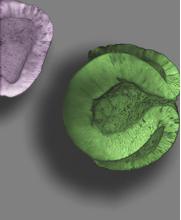Stem cells used to create retinal tissue
April 7, 2011

Retinal tissue created by embryonic stem cells (credit: M. Eiraku and Y.Sasai, RIKEN Center for Developmental Biology)
Researchers at the RIKIN Four-dimensional Tissue Analysis Unit and colleagues in the Laboratory for Neurogenesis and Organogenesis and Kyoto and Osaka Universities have demonstrated how mouse embryonic stem cells (ESCs) are able to differentiate and assemble into an optic cup.
The study used a three-dimensional tissue culture system to demonstrate the self-organizing capacity of pluripotent stem cells to give rise to a tissue exhibiting the stratified structure characteristic of a retina.
The researchers used the SFEBq (serum-free culture of embryoid body-like aggregates) cell culture system. They added extracellular matrix proteins to the SFEBq medium to epithelially organize retinal precursors at high efficiencies. After a week, an optic vesicle-like structure began to form, followed by bi-layered optic cup-like structures.
They used 3D multi-photon microscopy to explore the mechanisms behind this process of self-assembly. They found that after the stem cell-derived retinal precursors differentiated into pigmented epithelial and neuronal layers, the tissue underwent a four-step morphological rearrangement on its way to assuming the optic cup structure.
The study demonstrates that retinal precursors have the inherent ability to give rise to the complex structure of an optic cup, resolving a previously open question in regenerative medicine.
Ref.: Mototsugu Eiraku et al., Self-organizing optic-cup morphogenesis in three-dimensional culture, Nature, April 6, 2011